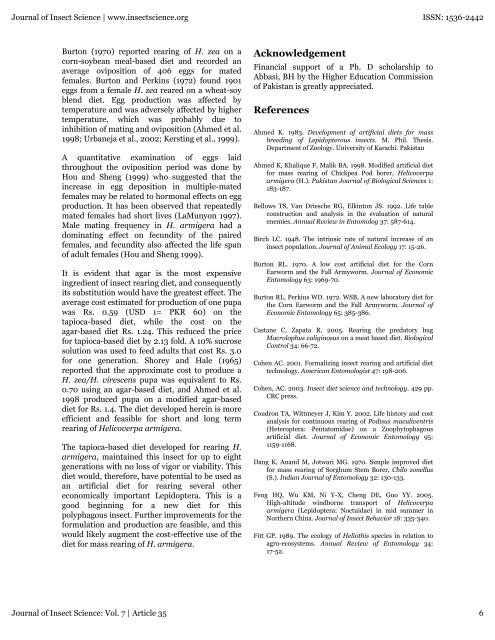Rearing the cotton bollworm, Helicoverpa armigera, on a tapioca ...
Rearing the cotton bollworm, Helicoverpa armigera, on a tapioca ...
Rearing the cotton bollworm, Helicoverpa armigera, on a tapioca ...
You also want an ePaper? Increase the reach of your titles
YUMPU automatically turns print PDFs into web optimized ePapers that Google loves.
Journal of Insect Science | www.insectscience.org ISSN: 1536-2442<br />
Burt<strong>on</strong> (1970) reported rearing of H. zea <strong>on</strong> a<br />
corn-soybean meal-based diet and recorded an<br />
average ovipositi<strong>on</strong> of 406 eggs for mated<br />
females. Burt<strong>on</strong> and Perkins (1972) found 1901<br />
eggs from a female H. zea reared <strong>on</strong> a wheat-soy<br />
blend diet. Egg producti<strong>on</strong> was affected by<br />
temperature and was adversely affected by higher<br />
temperature, which was probably due to<br />
inhibiti<strong>on</strong> of mating and ovipositi<strong>on</strong> (Ahmed et al.<br />
1998; Urbaneja et al., 2002; Kersting et al., 1999).<br />
A quantitative examinati<strong>on</strong> of eggs laid<br />
throughout <str<strong>on</strong>g>the</str<strong>on</strong>g> ovipositi<strong>on</strong> period was d<strong>on</strong>e by<br />
Hou and Sheng (1999) who suggested that <str<strong>on</strong>g>the</str<strong>on</strong>g><br />
increase in egg depositi<strong>on</strong> in multiple-mated<br />
females may be related to horm<strong>on</strong>al effects <strong>on</strong> egg<br />
producti<strong>on</strong>. It has been observed that repeatedly<br />
mated females had short lives (LaMuny<strong>on</strong> 1997).<br />
Male mating frequency in H. <str<strong>on</strong>g>armigera</str<strong>on</strong>g> had a<br />
dominating effect <strong>on</strong> fecundity of <str<strong>on</strong>g>the</str<strong>on</strong>g> paired<br />
females, and fecundity also affected <str<strong>on</strong>g>the</str<strong>on</strong>g> life span<br />
of adult females (Hou and Sheng 1999).<br />
It is evident that agar is <str<strong>on</strong>g>the</str<strong>on</strong>g> most expensive<br />
ingredient of insect rearing diet, and c<strong>on</strong>sequently<br />
its substituti<strong>on</strong> would have <str<strong>on</strong>g>the</str<strong>on</strong>g> greatest effect. The<br />
average cost estimated for producti<strong>on</strong> of <strong>on</strong>e pupa<br />
was Rs. 0.59 (USD 1= PKR 60) <strong>on</strong> <str<strong>on</strong>g>the</str<strong>on</strong>g><br />
<strong>tapioca</strong>-based diet, while <str<strong>on</strong>g>the</str<strong>on</strong>g> cost <strong>on</strong> <str<strong>on</strong>g>the</str<strong>on</strong>g><br />
agar-based diet Rs. 1.24. This reduced <str<strong>on</strong>g>the</str<strong>on</strong>g> price<br />
for <strong>tapioca</strong>-based diet by 2.13 fold. A 10% sucrose<br />
soluti<strong>on</strong> was used to feed adults that cost Rs. 3.0<br />
for <strong>on</strong>e generati<strong>on</strong>. Shorey and Hale (1965)<br />
reported that <str<strong>on</strong>g>the</str<strong>on</strong>g> approximate cost to produce a<br />
H. zea/H. virescens pupa was equivalent to Rs.<br />
0.70 using an agar-based diet, and Ahmed et al.<br />
1998 produced pupa <strong>on</strong> a modified agar-based<br />
diet for Rs. 1.4. The diet developed herein is more<br />
efficient and feasible for short and l<strong>on</strong>g term<br />
rearing of <str<strong>on</strong>g>Helicoverpa</str<strong>on</strong>g> <str<strong>on</strong>g>armigera</str<strong>on</strong>g>.<br />
The <strong>tapioca</strong>-based diet developed for rearing H.<br />
<str<strong>on</strong>g>armigera</str<strong>on</strong>g>, maintained this insect for up to eight<br />
generati<strong>on</strong>s with no loss of vigor or viability. This<br />
diet would, <str<strong>on</strong>g>the</str<strong>on</strong>g>refore, have potential to be used as<br />
an artificial diet for rearing several o<str<strong>on</strong>g>the</str<strong>on</strong>g>r<br />
ec<strong>on</strong>omically important Lepidoptera. This is a<br />
good beginning for a new diet for this<br />
polyphagous insect. Fur<str<strong>on</strong>g>the</str<strong>on</strong>g>r improvements for <str<strong>on</strong>g>the</str<strong>on</strong>g><br />
formulati<strong>on</strong> and producti<strong>on</strong> are feasible, and this<br />
would likely augment <str<strong>on</strong>g>the</str<strong>on</strong>g> cost-effective use of <str<strong>on</strong>g>the</str<strong>on</strong>g><br />
diet for mass rearing of H. <str<strong>on</strong>g>armigera</str<strong>on</strong>g>.<br />
Acknowledgement<br />
Financial support of a Ph. D scholarship to<br />
Abbasi, BH by <str<strong>on</strong>g>the</str<strong>on</strong>g> Higher Educati<strong>on</strong> Commissi<strong>on</strong><br />
of Pakistan is greatly appreciated.<br />
References<br />
Ahmed K. 1983. Development of artificial diets for mass<br />
breeding of Lepidopterous insects. M. Phil. Thesis.<br />
Department of Zoology. University of Karachi. Pakistan<br />
Ahmed K, Khalique F, Malik BA. 1998. Modified artificial diet<br />
for mass rearing of Chickpea Pod borer, <str<strong>on</strong>g>Helicoverpa</str<strong>on</strong>g><br />
<str<strong>on</strong>g>armigera</str<strong>on</strong>g> (H.). Pakistan Journal of Biological Sciences 1:<br />
183-187.<br />
Bellows TS, Van Driesche RG, Elkint<strong>on</strong> JS. 1992. Life table<br />
c<strong>on</strong>structi<strong>on</strong> and analysis in <str<strong>on</strong>g>the</str<strong>on</strong>g> evaluati<strong>on</strong> of natural<br />
enemies. Annual Review in Entomolog 37: 587-614.<br />
Birch LC. 1948. The intrinsic rate of natural increase of an<br />
insect populati<strong>on</strong>. Journal of Animal Ecology 17: 15-26.<br />
Burt<strong>on</strong> RL. 1970. A low cost artificial diet for <str<strong>on</strong>g>the</str<strong>on</strong>g> Corn<br />
Earworm and <str<strong>on</strong>g>the</str<strong>on</strong>g> Fall Armyworm. Journal of Ec<strong>on</strong>omic<br />
Entomology 63: 1969-70.<br />
Burt<strong>on</strong> RL, Perkins WD. 1972. WSB, A new laboratory diet for<br />
<str<strong>on</strong>g>the</str<strong>on</strong>g> Corn Earworm and <str<strong>on</strong>g>the</str<strong>on</strong>g> Fall Armyworm. Journal of<br />
Ec<strong>on</strong>omic Entomology 65: 385-386.<br />
Castane C, Zapata R. 2005. <str<strong>on</strong>g>Rearing</str<strong>on</strong>g> <str<strong>on</strong>g>the</str<strong>on</strong>g> predatory bug<br />
Macrolophus caliginosus <strong>on</strong> a meat based diet. Biological<br />
C<strong>on</strong>trol 34: 66-72.<br />
Cohen AC. 2001. Formalizing insect rearing and artificial diet<br />
technology. American Entomologist 47: 198-206.<br />
Cohen, AC. 2003. Insect diet science and technology. 429 pp.<br />
CRC press.<br />
Coudr<strong>on</strong> TA, Wittmeyer J, Kim Y. 2002. Life history and cost<br />
analysis for c<strong>on</strong>tinuous rearing of Podisus maculiventris<br />
(Heteroptera: Pentatomidae) <strong>on</strong> a Zoophytophagous<br />
artificial diet. Journal of Ec<strong>on</strong>omic Entomology 95:<br />
1159-1168.<br />
Dang K, Anand M, Jotwari MG. 1970. Simple improved diet<br />
for mass rearing of Sorghum Stem Borer, Chilo z<strong>on</strong>ellus<br />
(S.). Indian Journal of Entomology 32: 130-133.<br />
Feng HQ, Wu KM, Ni Y-X, Cheng DE, Guo YY. 2005.<br />
High-altitude windborne transport of <str<strong>on</strong>g>Helicoverpa</str<strong>on</strong>g><br />
<str<strong>on</strong>g>armigera</str<strong>on</strong>g> (Lepidoptera: Noctuidae) in mid summer in<br />
Nor<str<strong>on</strong>g>the</str<strong>on</strong>g>rn China. Journal of Insect Behavior 18: 335-340.<br />
Fitt GP. 1989. The ecology of Heliothis species in relati<strong>on</strong> to<br />
agro-ecosystems. Annual Review of Entomology 34:<br />
17-52.<br />
Journal of Insect Science: Vol. 7 | Article 35 6
















